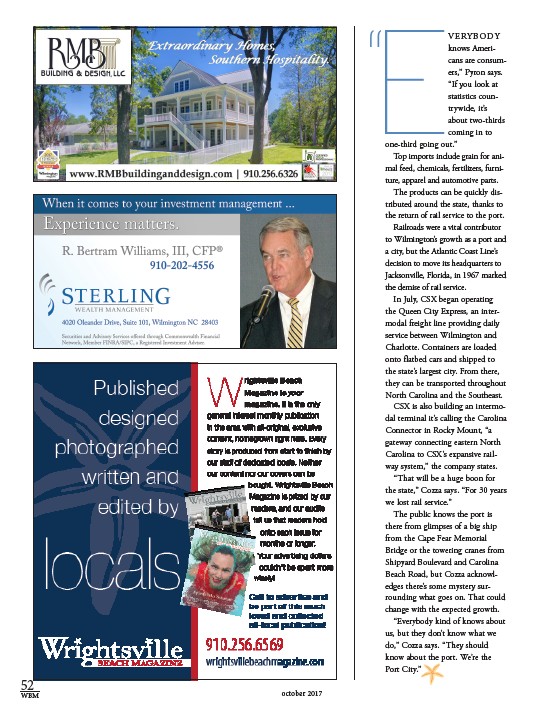
52
WBM october 2017
VERYBODY
knows Americans
are consum-ers,”
Pyron says.
“If you look at
statistics coun-trywide,
it’s
about two-thirds
coming in to
one-third going out.”
Top imports include grain for ani-mal
feed, chemicals, fertilizers, furni-ture,
apparel and automotive parts.
The products can be quickly dis-tributed
around the state, thanks to
the return of rail service to the port.
Railroads were a vital contributor
to Wilmington’s growth as a port and
a city, but the Atlantic Coast Line’s
decision to move its headquarters to
Jacksonville, Florida, in 1967 marked
the demise of rail service.
In July, CSX began operating
the Queen City Express, an inter-modal
freight line providing daily
service between Wilmington and
Charlotte. Containers are loaded
onto flatbed cars and shipped to
the state’s largest city. From there,
they can be transported throughout
North Carolina and the Southeast.
CSX is also building an intermo-dal
terminal it’s calling the Carolina
Connector in Rocky Mount, “a
gateway connecting eastern North
Carolina to CSX’s expansive rail-way
system,” the company states.
“That will be a huge boon for
the state,” Cozza says. “For 30 years
we lost rail service.”
The public knows the port is
there from glimpses of a big ship
from the Cape Fear Memorial
Bridge or the towering cranes from
Shipyard Boulevard and Carolina
Beach Road, but Cozza acknowl-edges
there’s some mystery sur-rounding
what goes on. That could
change with the expected growth.
“Everybody kind of knows about
us, but they don’t know what we
do,” Cozza says. “They should
know about the port. We’re the
Port City.”
E“